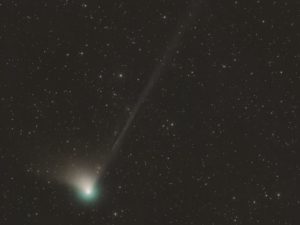Comet ZTF made its closest approach to Earth on Feb. 1 at a distance of 26 million miles. That’s pretty close. Mars, for example, is, on average, 140 million miles from Earth. The comet received a lot of coverage in the news. With a clear sky and away from urban and suburban lights you could see it — faintly — with the unaided eye.
Before ZTF swung by, Earth had another visitor from deep space that you may have heard about. Asteroid 2023 BU passed within 2,200 miles of Earth on Jan. 27. That’s extremely close. Our own Moon is about 220,000 miles away. This asteroid whipped by at about the same altitude as many satellites. Near misses don’t get much closer than that.
But there was little danger: 2023 BU is essentially a rock about 25 feet across. An asteroid that size would likely break apart in the upper atmosphere into many smaller pieces, called meteors (for more about meteors, see “Watching for Beautiful Bursts of Cosmic Debris” in the Nov. 17, 2022 issue of the Independent). Any meteors of that size that survived to strike the ground would be large enough to cause only minor damage to roofs, cars, or extremely unlucky people standing in the open.

Comets, planets, and asteroids are three different types of astronomical bodies — objects in space. But there are times astronomical definitions can get tricky.
Comets are relatively small bodies, averaging three miles in diameter. They’re like dirty snowballs: amalgamations of ice, frozen carbon dioxide, ammonia, and other compounds, plus dust, pebbles, and boulders. Comets spend most of their long orbital travels far from the Sun where it’s very cold: minus 300 degrees Fahrenheit and below. But when their orbits bring them close to the Sun, the ice and frozen compounds begin to vaporize. The trail of vapor and released dust and rocks reflect sunlight: the comet’s tail. This is when a comet becomes visible to us for a short time. After rounding the Sun, the comet heads back to the outer solar system. Its tail disappears when it gets far enough away that the ice stops vaporizing.
Planets are familiar to us. We live on one. Astronomers define planets as large, rounded astronomical bodies that aren’t stars. (A star is an even larger ball of plasma, bound by gravity and generating energy from nuclear fusion in its core.) Planets aren’t powered by nuclear fusion, aren’t as big as stars, and are spherical. Examples include Mercury, Earth, and Jupiter, which demonstrate the range of forms that planets can take. Mercury: a small terrestrial (rocky) planet with no atmosphere or liquid water. Earth: a medium-sized terrestrial planet with a thick atmosphere and liquid water on the surface. Jupiter: a giant gas planet 11 times the size of Earth, with no solid surface and a miniature solar system unto itself with over 90 moons.
Asteroids are different. One way to think of them is that they’re rocks in space. Some are very small, like our recent visitor. Many are the size of buildings or mountains. And some are big enough to be called dwarf planets. That is, not quite big enough to be full-fledged planets but still deserving of a title distinct from irregular-shaped tumbling boulders like 2023 BU. Ceres, 580 miles in diameter and the largest resident of the asteroid belt (a region of the solar system between Mars and Jupiter populated by millions of asteroids), is a dwarf planet.
But here’s the tricky part. So is Pluto. Which astronomers used to classify as a planet. Pluto was demoted in 2006 when the International Astronomical Union updated its definitions for astronomical bodies. It satisfies two out of three of the IAU’s criteria: it orbits the Sun and it has sufficient mass to assume hydrostatic equilibrium, meaning it’s big enough that its own gravity forms it into a sphere. But it has not, they note, “cleared the neighborhood” around its orbit. That is, it is not gravitationally dominant. There are other objects, including bigger ones, in Pluto’s orbit.
Some astronomers, professionals and amateurs alike, object to the demotion and stubbornly continue to call Pluto a planet, this writer among them. A new definition derived from new discoveries and improved understanding is a good thing — that’s science. But we objectors feel that Pluto deserved an exception. After all, it had been a planet since it was discovered. And besides, we grew up learning clever mnemonics to memorize the nine planets. Who could ever forget Mary’s Violet Eyes Make Johnny Stay Up Nights Pondering? Clear skies!



